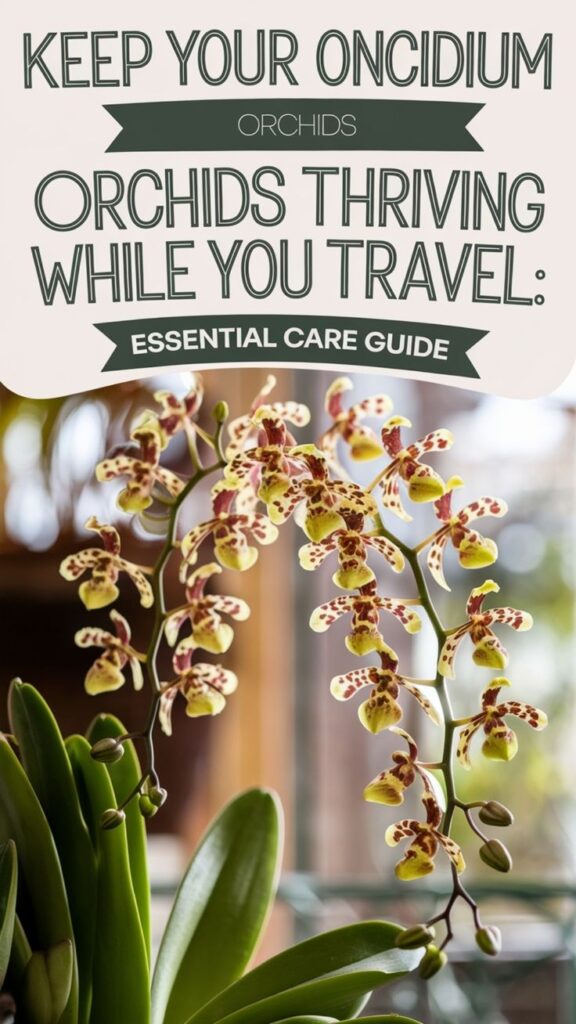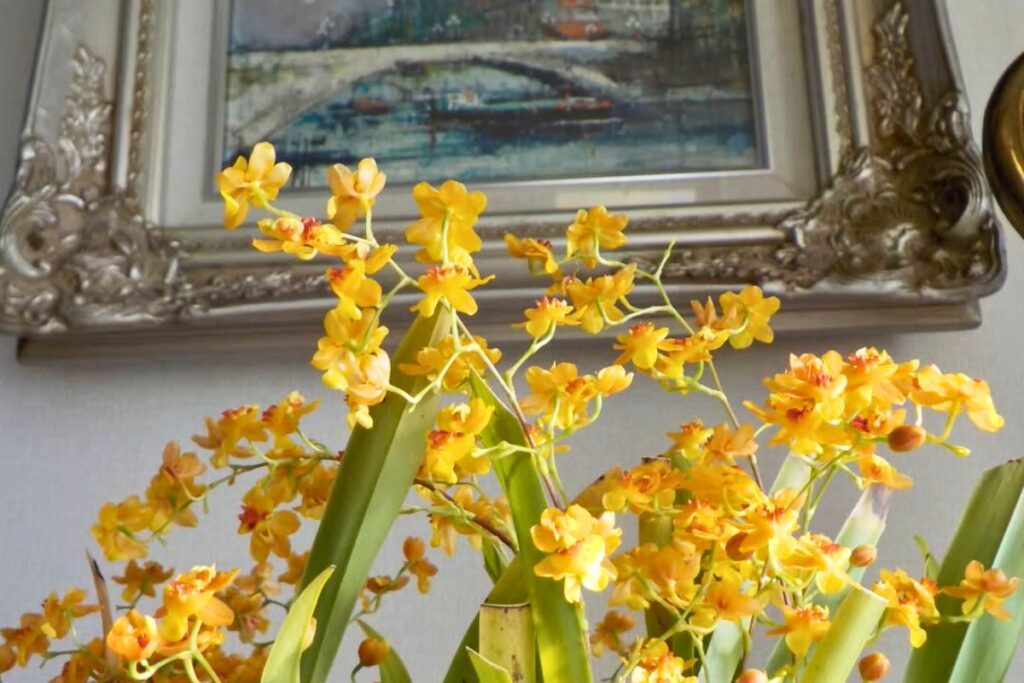Just as frequent flyers need a reliable travel checklist, your Oncidium orchids require careful preparation before you jet off on vacation. You’ll want to start planning 7-10 days before departure to guarantee your prized plants don’t suffer while you’re away. From setting up automated watering systems to creating detailed care instructions for plant sitters, there’s quite a bit to take into account – and a few clever tricks that can make all the difference between returning to thriving blooms or wilted disappointment.

Contents
Preparing Your Orchids Before Departure
Before commencing any journey with your Oncidium orchids, you’ll need to start preparations at least 7-10 days in advance. Begin by checking for any pests or diseases, treating issues immediately with appropriate solutions. Water your orchids thoroughly, but allow the growing medium to dry slightly before travel.
Trim away any dead or yellowing leaves, spent flower spikes, and damaged pseudobulbs. You’ll want to secure loose stems with plant stakes and soft ties, preventing breakage during transport. If your orchids are in bloom, consider removing open flowers to reduce stress.
Finally, adjust your plant’s location to moderate light and temperatures around 65-75°F for gradual acclimation.
Setting Up an Automatic Watering System
While you’re away, a reliable automatic watering system serves as your orchids’ lifeline. Set up a gravity-fed drip system with 1/4-inch tubing and adjustable emitters positioned 2 inches from each orchid’s base. You’ll need one emitter per plant, calibrated to deliver 4-6 drops per minute.
Attach the main water reservoir at least 2 feet above your orchids, ensuring steady water pressure. Fill it with filtered water and test the system for 24 hours before departure. Add a battery-powered timer to regulate watering sessions – program it for 3-minute intervals every third day, adjusting based on your climate and season.
Creating the Ideal Environment While Away

Your Oncidium orchid needs specific environmental conditions to thrive while you’re away, so let’s focus on the three key factors you’ll need to control. You’ll want to maintain humidity between 40-60% using a humidifier with an automatic shutoff, while positioning your orchids where they’ll receive bright, indirect light for 6-8 hours daily. Set your home’s thermostat to maintain temperatures between 65-80°F (18-27°C), avoiding any drafts from air vents or windows that could cause temperature fluctuations.
Maintain Stable Air Humidity
Since humidity levels directly impact an Oncidium orchid’s health during travel, maintaining stable moisture in the air requires strategic planning. Place a humidity tray filled with pebbles and water beneath your orchid, ensuring the pot sits above the water line to prevent root rot.
You’ll want to maintain 40-60% humidity during transport. Create a makeshift greenhouse by securing a clear plastic bag over your orchid, leaving small air holes for ventilation. Don’t forget to mist the inside of the bag before sealing it.
For trips longer than three days, add moistened sphagnum moss around the pot’s base to provide consistent humidity release.
Set Proper Light Conditions
Finding the right light balance for traveling Oncidium orchids can make or break their journey. During transport, you’ll want to place your orchids in filtered, indirect light that mimics their natural growing conditions.
Position your plants 3-4 feet away from east or north-facing windows to protect them from harsh direct sunlight. If you’re leaving them with a caretaker, mark the ideal spot with tape or sticky notes to guarantee consistent placement.
For trips longer than a week, consider installing temporary sheer curtains or using adjustable blinds to maintain 70-85% shade. Don’t place orchids in dark corners or full sun, as either extreme can stress the plants.
Control Room Temperature Range
To keep Oncidium orchids thriving during travel, maintaining a consistent temperature range between 65-80°F (18-27°C) is essential. You’ll need to plan ahead by setting your thermostat to maintain these temperatures, even when you’re away.
During daytime hours, aim for temperatures closer to 80°F, while allowing a natural drop to 65°F at night. If you’re leaving during winter, place your orchids away from drafty windows and cold air vents. For summer travels, position them at least 3 feet from air conditioning units to prevent cold spots.
Install a digital thermometer with high/low readings to monitor temperature fluctuations while you’re gone.
Emergency Care Instructions for Plant Sitters
When you’re away from your Oncidium orchids, your plant sitter needs clear emergency guidelines to handle unexpected issues. Create a detailed care sheet listing your orchid’s normal watering schedule, light requirements, and fertilizing routine.
Provide contact information for both you and a local orchid expert. Include photos of healthy vs. problematic leaves, and mark the ideal moisture level on your orchid’s pot. If yellow leaves appear, instruct them to reduce watering by 50%. For pest infestations, leave a premixed solution of neem oil with specific application instructions.
List warning signs like root rot or crown issues that require immediate professional intervention.
Preventive Measures Against Common Problems
Since many orchid problems can be prevented through proper care routines, establishing good habits early will protect your Oncidium from common issues. Monitor your watering schedule closely, allowing the top inch of media to dry between waterings, and don’t let water collect in the crown.
Check your orchid’s leaves weekly for signs of pests or disease, particularly spider mites and scale insects. You’ll want to maintain humidity between 40-60% using a humidity tray or small humidifier, but make sure proper air circulation with a gentle fan to prevent fungal issues.
Clean your pruning tools with 70% isopropyl alcohol before each use to avoid spreading pathogens between plants.
Post-Travel Recovery and Maintenance
After your Oncidium returns home from travel, it’ll need 7-10 days to readjust to its normal growing environment. Place it in a spot with filtered light and maintain temperatures between 65-80°F, gradually reintroducing your regular watering schedule.
Check the potting media’s moisture level daily, and don’t water until the top inch feels dry. You’ll want to inspect leaves and roots for any travel-related damage or stress symptoms, like yellowing or black spots.
Resume fertilizing after two weeks, using a balanced orchid formula at quarter-strength. If you notice any pest issues, isolate the plant and treat with appropriate remedies before returning it to your collection.
